Student Overall Assessment Record Sheet Qualification Code: Title HLT54115 - Diploma of Nursing
VerifiedAdded on 2022/11/16
|15
|3774
|398
AI Summary
Assessments Details:
This document has three assessments for HLT54115 Diploma of Nursing qualification on the unit: HLTINF001 Comply with infection prevention and control policies and procedures.
Assessment 1: Underpinning Knowledge/Questions
Assessment 2: Research Work/Project
Assessment 3: Observation
Contribute Materials
Your contribution can guide someone’s learning journey. Share your
documents today.
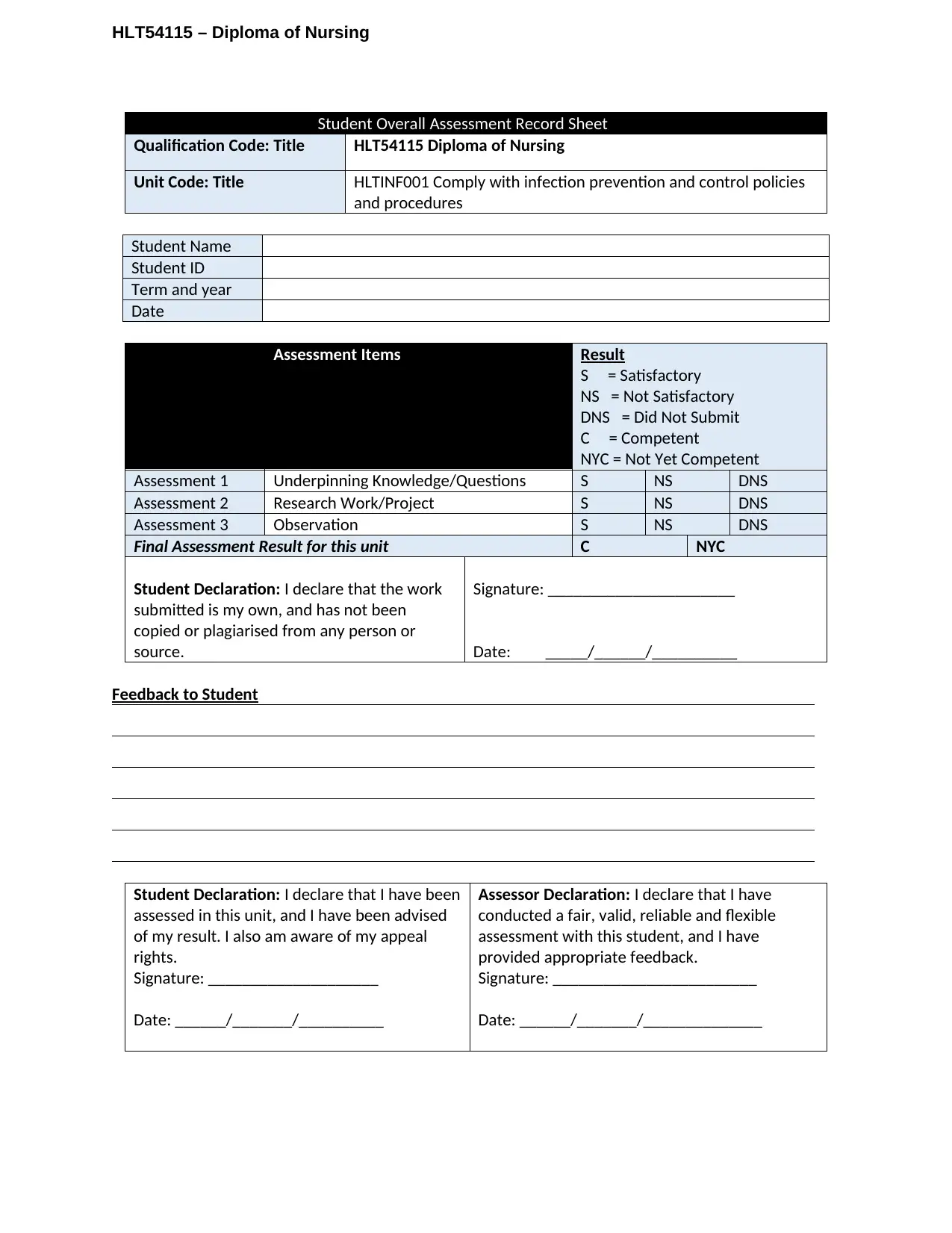
HLT54115 – Diploma of Nursing
Student Overall Assessment Record Sheet
Qualification Code: Title HLT54115 Diploma of Nursing
Unit Code: Title HLTINF001 Comply with infection prevention and control policies
and procedures
Student Name
Student ID
Term and year
Date
Assessment Items Result
S = Satisfactory
NS = Not Satisfactory
DNS = Did Not Submit
C = Competent
NYC = Not Yet Competent
Assessment 1 Underpinning Knowledge/Questions S NS DNS
Assessment 2 Research Work/Project S NS DNS
Assessment 3 Observation S NS DNS
Final Assessment Result for this unit C NYC
Student Declaration: I declare that the work
submitted is my own, and has not been
copied or plagiarised from any person or
source.
Signature: ______________________
Date: _____/______/__________
Feedback to Student
Student Declaration: I declare that I have been
assessed in this unit, and I have been advised
of my result. I also am aware of my appeal
rights.
Signature: ____________________
Date: ______/_______/__________
Assessor Declaration: I declare that I have
conducted a fair, valid, reliable and flexible
assessment with this student, and I have
provided appropriate feedback.
Signature: ________________________
Date: ______/_______/______________
Student Overall Assessment Record Sheet
Qualification Code: Title HLT54115 Diploma of Nursing
Unit Code: Title HLTINF001 Comply with infection prevention and control policies
and procedures
Student Name
Student ID
Term and year
Date
Assessment Items Result
S = Satisfactory
NS = Not Satisfactory
DNS = Did Not Submit
C = Competent
NYC = Not Yet Competent
Assessment 1 Underpinning Knowledge/Questions S NS DNS
Assessment 2 Research Work/Project S NS DNS
Assessment 3 Observation S NS DNS
Final Assessment Result for this unit C NYC
Student Declaration: I declare that the work
submitted is my own, and has not been
copied or plagiarised from any person or
source.
Signature: ______________________
Date: _____/______/__________
Feedback to Student
Student Declaration: I declare that I have been
assessed in this unit, and I have been advised
of my result. I also am aware of my appeal
rights.
Signature: ____________________
Date: ______/_______/__________
Assessor Declaration: I declare that I have
conducted a fair, valid, reliable and flexible
assessment with this student, and I have
provided appropriate feedback.
Signature: ________________________
Date: ______/_______/______________
Secure Best Marks with AI Grader
Need help grading? Try our AI Grader for instant feedback on your assignments.
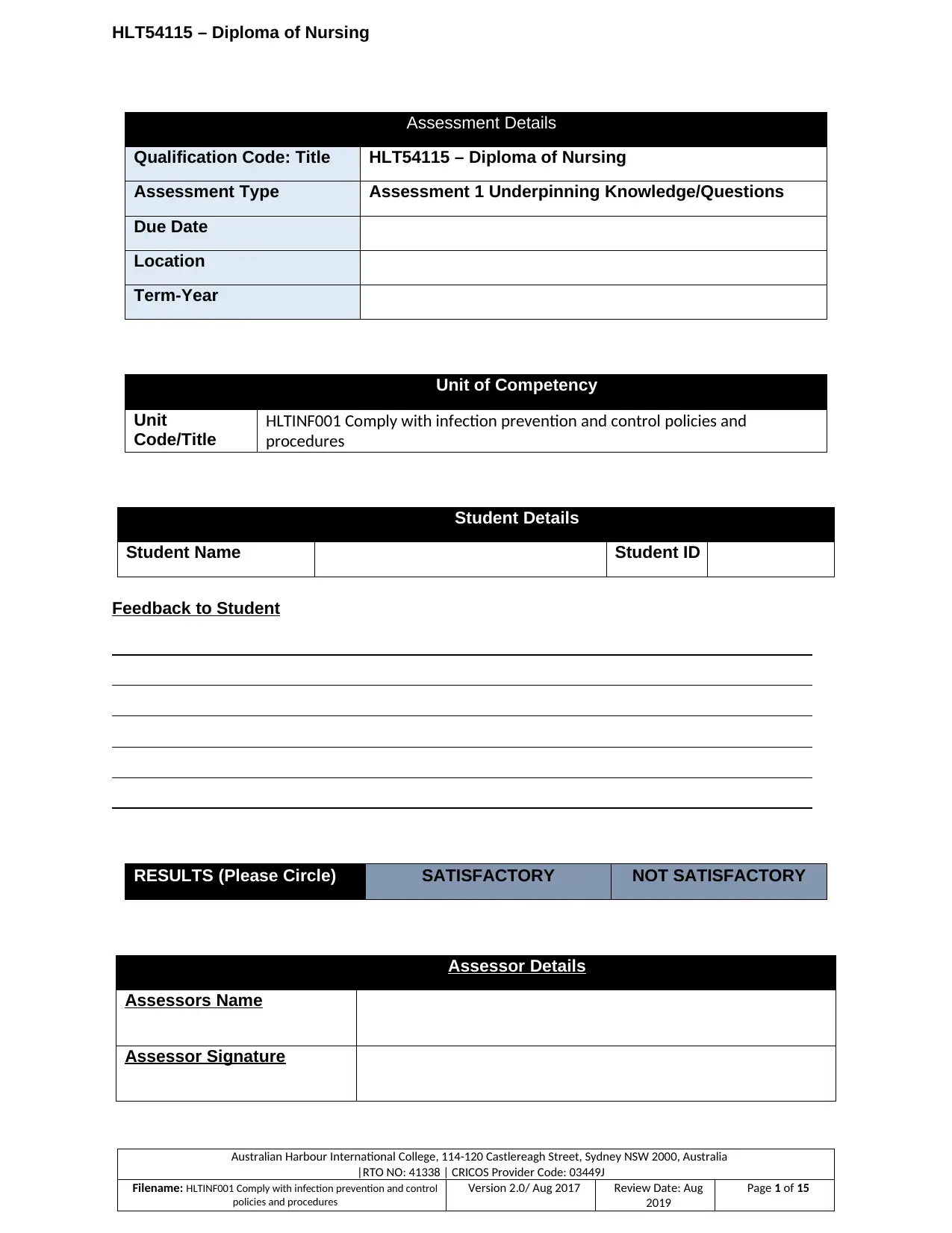
HLT54115 – Diploma of Nursing
Assessment Details
Qualification Code: Title HLT54115 – Diploma of Nursing
Assessment Type Assessment 1 Underpinning Knowledge/Questions
Due Date
Location
Term-Year
Unit of Competency
Unit
Code/Title
HLTINF001 Comply with infection prevention and control policies and
procedures
Student Details
Student Name Student ID
Feedback to Student
RESULTS (Please Circle) SATISFACTORY NOT SATISFACTORY
Assessor Details
Assessors Name
Assessor Signature
Australian Harbour International College, 114-120 Castlereagh Street, Sydney NSW 2000, Australia
|RTO NO: 41338 | CRICOS Provider Code: 03449J
Filename: HLTINF001 Comply with infection prevention and control
policies and procedures
Version 2.0/ Aug 2017 Review Date: Aug
2019
Page 1 of 15
Assessment Details
Qualification Code: Title HLT54115 – Diploma of Nursing
Assessment Type Assessment 1 Underpinning Knowledge/Questions
Due Date
Location
Term-Year
Unit of Competency
Unit
Code/Title
HLTINF001 Comply with infection prevention and control policies and
procedures
Student Details
Student Name Student ID
Feedback to Student
RESULTS (Please Circle) SATISFACTORY NOT SATISFACTORY
Assessor Details
Assessors Name
Assessor Signature
Australian Harbour International College, 114-120 Castlereagh Street, Sydney NSW 2000, Australia
|RTO NO: 41338 | CRICOS Provider Code: 03449J
Filename: HLTINF001 Comply with infection prevention and control
policies and procedures
Version 2.0/ Aug 2017 Review Date: Aug
2019
Page 1 of 15
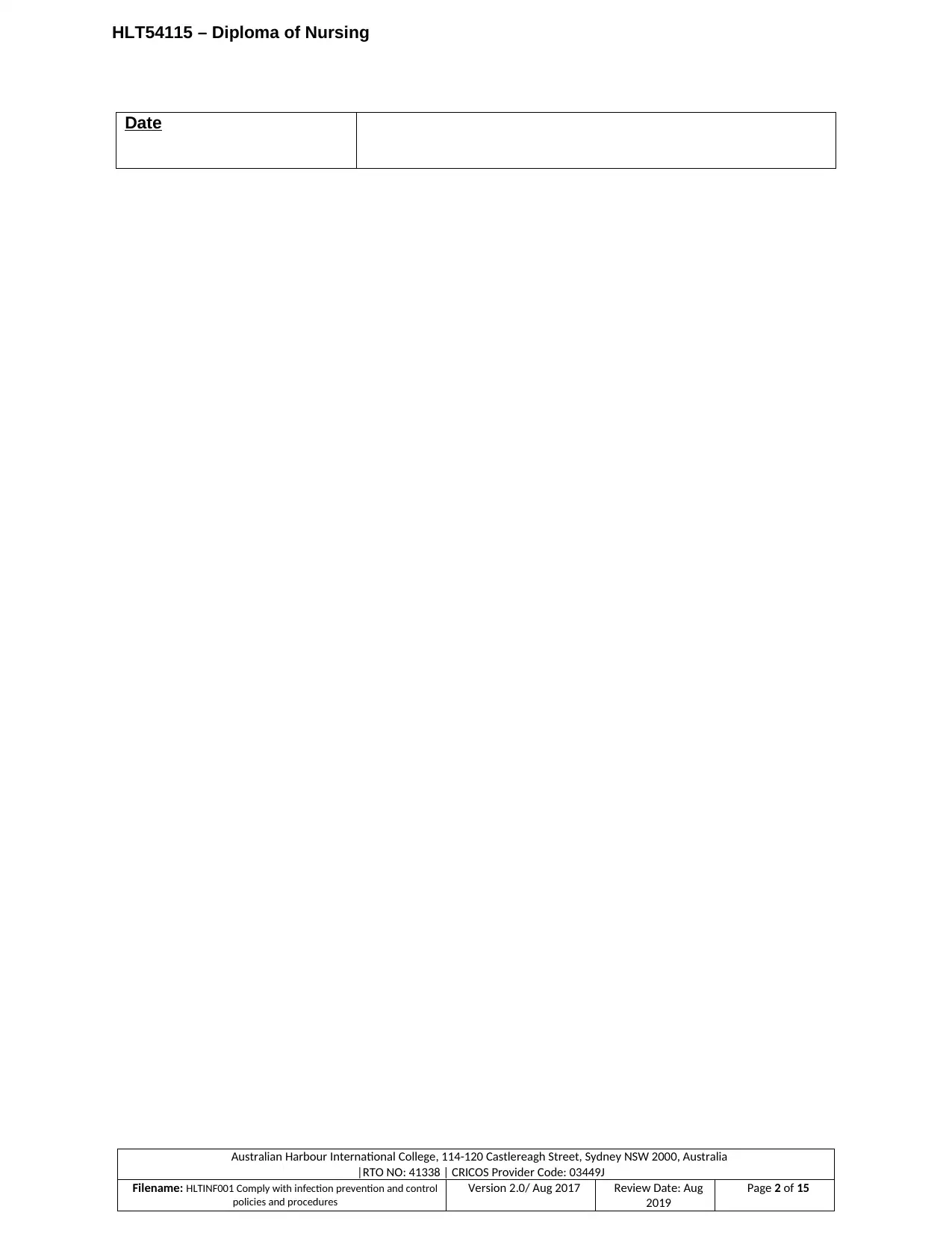
HLT54115 – Diploma of Nursing
Date
Australian Harbour International College, 114-120 Castlereagh Street, Sydney NSW 2000, Australia
|RTO NO: 41338 | CRICOS Provider Code: 03449J
Filename: HLTINF001 Comply with infection prevention and control
policies and procedures
Version 2.0/ Aug 2017 Review Date: Aug
2019
Page 2 of 15
Date
Australian Harbour International College, 114-120 Castlereagh Street, Sydney NSW 2000, Australia
|RTO NO: 41338 | CRICOS Provider Code: 03449J
Filename: HLTINF001 Comply with infection prevention and control
policies and procedures
Version 2.0/ Aug 2017 Review Date: Aug
2019
Page 2 of 15
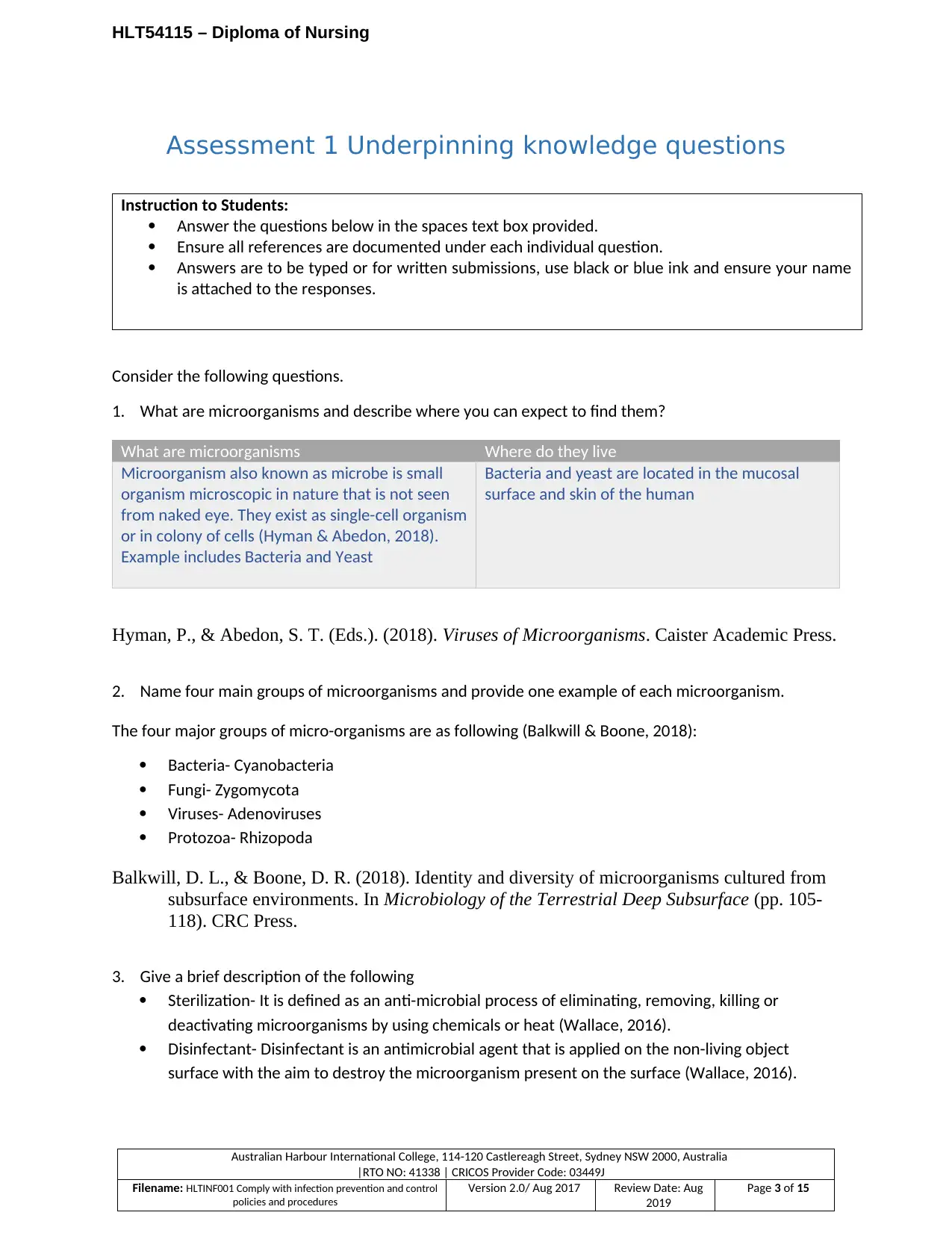
HLT54115 – Diploma of Nursing
Assessment 1 Underpinning knowledge questions
Instruction to Students:
Answer the questions below in the spaces text box provided.
Ensure all references are documented under each individual question.
Answers are to be typed or for written submissions, use black or blue ink and ensure your name
is attached to the responses.
Consider the following questions.
1. What are microorganisms and describe where you can expect to find them?
What are microorganisms Where do they live
Microorganism also known as microbe is small
organism microscopic in nature that is not seen
from naked eye. They exist as single-cell organism
or in colony of cells (Hyman & Abedon, 2018).
Example includes Bacteria and Yeast
Bacteria and yeast are located in the mucosal
surface and skin of the human
Hyman, P., & Abedon, S. T. (Eds.). (2018). Viruses of Microorganisms. Caister Academic Press.
2. Name four main groups of microorganisms and provide one example of each microorganism.
The four major groups of micro-organisms are as following (Balkwill & Boone, 2018):
Bacteria- Cyanobacteria
Fungi- Zygomycota
Viruses- Adenoviruses
Protozoa- Rhizopoda
Balkwill, D. L., & Boone, D. R. (2018). Identity and diversity of microorganisms cultured from
subsurface environments. In Microbiology of the Terrestrial Deep Subsurface (pp. 105-
118). CRC Press.
3. Give a brief description of the following
Sterilization- It is defined as an anti-microbial process of eliminating, removing, killing or
deactivating microorganisms by using chemicals or heat (Wallace, 2016).
Disinfectant- Disinfectant is an antimicrobial agent that is applied on the non-living object
surface with the aim to destroy the microorganism present on the surface (Wallace, 2016).
Australian Harbour International College, 114-120 Castlereagh Street, Sydney NSW 2000, Australia
|RTO NO: 41338 | CRICOS Provider Code: 03449J
Filename: HLTINF001 Comply with infection prevention and control
policies and procedures
Version 2.0/ Aug 2017 Review Date: Aug
2019
Page 3 of 15
Assessment 1 Underpinning knowledge questions
Instruction to Students:
Answer the questions below in the spaces text box provided.
Ensure all references are documented under each individual question.
Answers are to be typed or for written submissions, use black or blue ink and ensure your name
is attached to the responses.
Consider the following questions.
1. What are microorganisms and describe where you can expect to find them?
What are microorganisms Where do they live
Microorganism also known as microbe is small
organism microscopic in nature that is not seen
from naked eye. They exist as single-cell organism
or in colony of cells (Hyman & Abedon, 2018).
Example includes Bacteria and Yeast
Bacteria and yeast are located in the mucosal
surface and skin of the human
Hyman, P., & Abedon, S. T. (Eds.). (2018). Viruses of Microorganisms. Caister Academic Press.
2. Name four main groups of microorganisms and provide one example of each microorganism.
The four major groups of micro-organisms are as following (Balkwill & Boone, 2018):
Bacteria- Cyanobacteria
Fungi- Zygomycota
Viruses- Adenoviruses
Protozoa- Rhizopoda
Balkwill, D. L., & Boone, D. R. (2018). Identity and diversity of microorganisms cultured from
subsurface environments. In Microbiology of the Terrestrial Deep Subsurface (pp. 105-
118). CRC Press.
3. Give a brief description of the following
Sterilization- It is defined as an anti-microbial process of eliminating, removing, killing or
deactivating microorganisms by using chemicals or heat (Wallace, 2016).
Disinfectant- Disinfectant is an antimicrobial agent that is applied on the non-living object
surface with the aim to destroy the microorganism present on the surface (Wallace, 2016).
Australian Harbour International College, 114-120 Castlereagh Street, Sydney NSW 2000, Australia
|RTO NO: 41338 | CRICOS Provider Code: 03449J
Filename: HLTINF001 Comply with infection prevention and control
policies and procedures
Version 2.0/ Aug 2017 Review Date: Aug
2019
Page 3 of 15
Secure Best Marks with AI Grader
Need help grading? Try our AI Grader for instant feedback on your assignments.
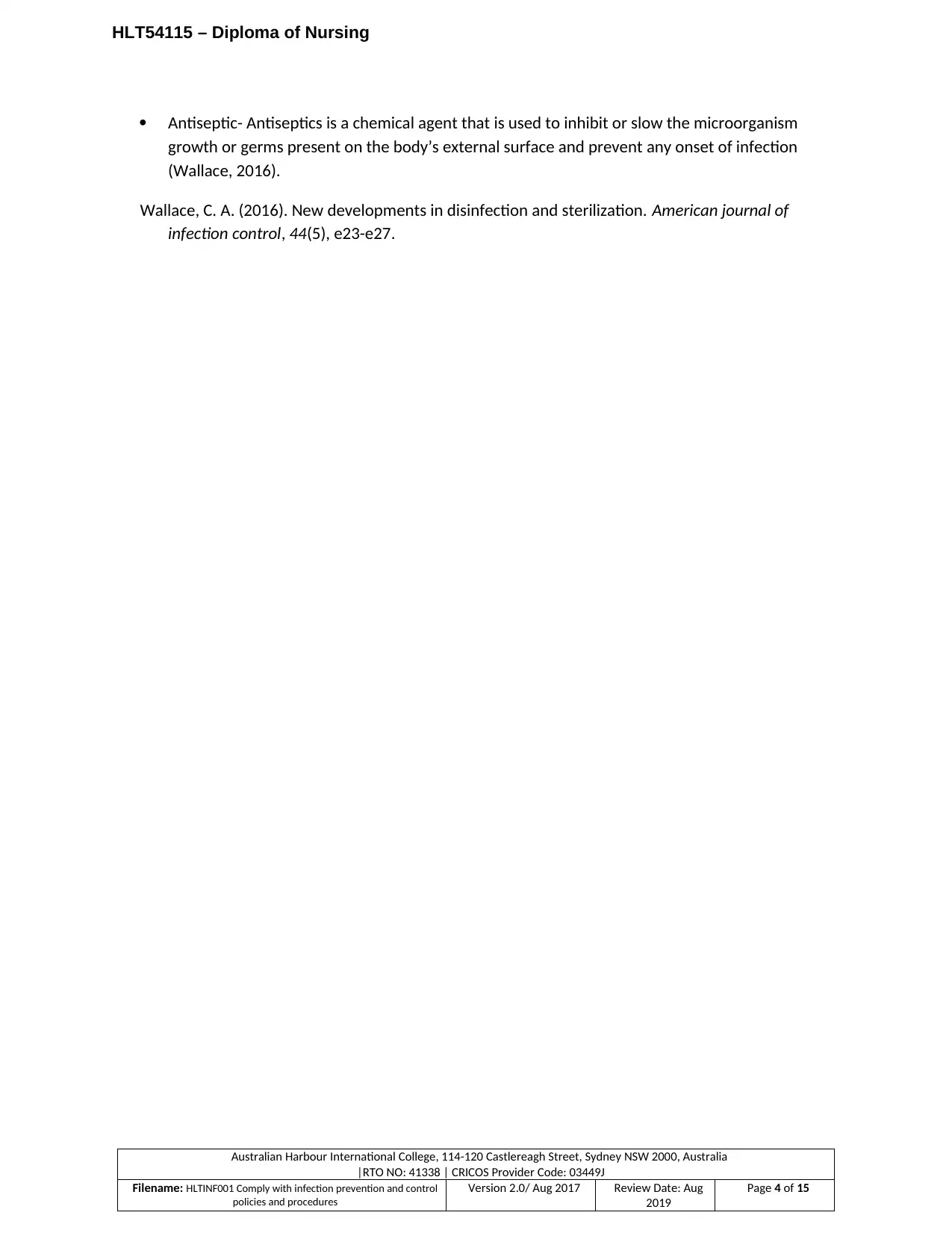
HLT54115 – Diploma of Nursing
Antiseptic- Antiseptics is a chemical agent that is used to inhibit or slow the microorganism
growth or germs present on the body’s external surface and prevent any onset of infection
(Wallace, 2016).
Wallace, C. A. (2016). New developments in disinfection and sterilization. American journal of
infection control, 44(5), e23-e27.
Australian Harbour International College, 114-120 Castlereagh Street, Sydney NSW 2000, Australia
|RTO NO: 41338 | CRICOS Provider Code: 03449J
Filename: HLTINF001 Comply with infection prevention and control
policies and procedures
Version 2.0/ Aug 2017 Review Date: Aug
2019
Page 4 of 15
Antiseptic- Antiseptics is a chemical agent that is used to inhibit or slow the microorganism
growth or germs present on the body’s external surface and prevent any onset of infection
(Wallace, 2016).
Wallace, C. A. (2016). New developments in disinfection and sterilization. American journal of
infection control, 44(5), e23-e27.
Australian Harbour International College, 114-120 Castlereagh Street, Sydney NSW 2000, Australia
|RTO NO: 41338 | CRICOS Provider Code: 03449J
Filename: HLTINF001 Comply with infection prevention and control
policies and procedures
Version 2.0/ Aug 2017 Review Date: Aug
2019
Page 4 of 15
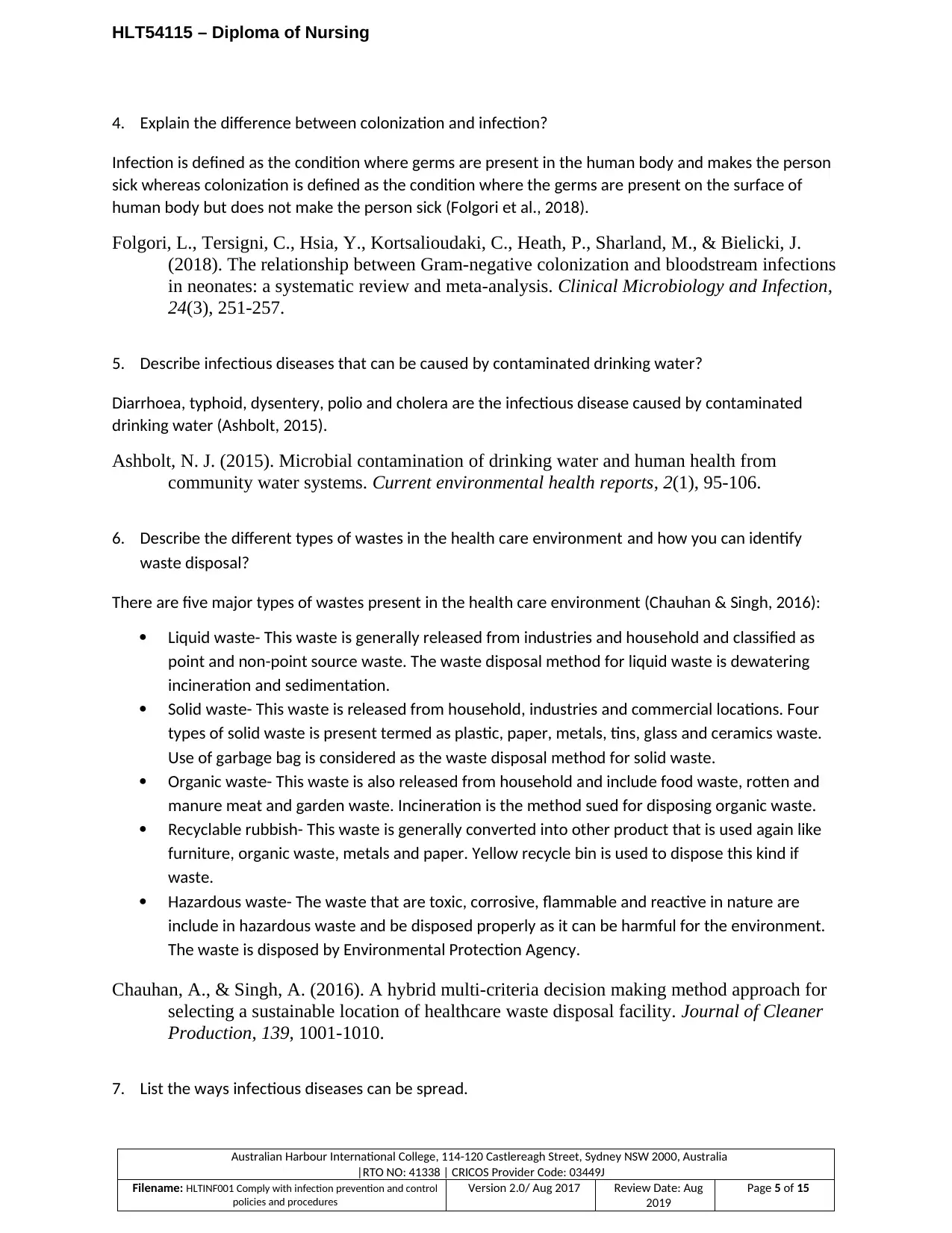
HLT54115 – Diploma of Nursing
4. Explain the difference between colonization and infection?
Infection is defined as the condition where germs are present in the human body and makes the person
sick whereas colonization is defined as the condition where the germs are present on the surface of
human body but does not make the person sick (Folgori et al., 2018).
Folgori, L., Tersigni, C., Hsia, Y., Kortsalioudaki, C., Heath, P., Sharland, M., & Bielicki, J.
(2018). The relationship between Gram-negative colonization and bloodstream infections
in neonates: a systematic review and meta-analysis. Clinical Microbiology and Infection,
24(3), 251-257.
5. Describe infectious diseases that can be caused by contaminated drinking water?
Diarrhoea, typhoid, dysentery, polio and cholera are the infectious disease caused by contaminated
drinking water (Ashbolt, 2015).
Ashbolt, N. J. (2015). Microbial contamination of drinking water and human health from
community water systems. Current environmental health reports, 2(1), 95-106.
6. Describe the different types of wastes in the health care environment and how you can identify
waste disposal?
There are five major types of wastes present in the health care environment (Chauhan & Singh, 2016):
Liquid waste- This waste is generally released from industries and household and classified as
point and non-point source waste. The waste disposal method for liquid waste is dewatering
incineration and sedimentation.
Solid waste- This waste is released from household, industries and commercial locations. Four
types of solid waste is present termed as plastic, paper, metals, tins, glass and ceramics waste.
Use of garbage bag is considered as the waste disposal method for solid waste.
Organic waste- This waste is also released from household and include food waste, rotten and
manure meat and garden waste. Incineration is the method sued for disposing organic waste.
Recyclable rubbish- This waste is generally converted into other product that is used again like
furniture, organic waste, metals and paper. Yellow recycle bin is used to dispose this kind if
waste.
Hazardous waste- The waste that are toxic, corrosive, flammable and reactive in nature are
include in hazardous waste and be disposed properly as it can be harmful for the environment.
The waste is disposed by Environmental Protection Agency.
Chauhan, A., & Singh, A. (2016). A hybrid multi-criteria decision making method approach for
selecting a sustainable location of healthcare waste disposal facility. Journal of Cleaner
Production, 139, 1001-1010.
7. List the ways infectious diseases can be spread.
Australian Harbour International College, 114-120 Castlereagh Street, Sydney NSW 2000, Australia
|RTO NO: 41338 | CRICOS Provider Code: 03449J
Filename: HLTINF001 Comply with infection prevention and control
policies and procedures
Version 2.0/ Aug 2017 Review Date: Aug
2019
Page 5 of 15
4. Explain the difference between colonization and infection?
Infection is defined as the condition where germs are present in the human body and makes the person
sick whereas colonization is defined as the condition where the germs are present on the surface of
human body but does not make the person sick (Folgori et al., 2018).
Folgori, L., Tersigni, C., Hsia, Y., Kortsalioudaki, C., Heath, P., Sharland, M., & Bielicki, J.
(2018). The relationship between Gram-negative colonization and bloodstream infections
in neonates: a systematic review and meta-analysis. Clinical Microbiology and Infection,
24(3), 251-257.
5. Describe infectious diseases that can be caused by contaminated drinking water?
Diarrhoea, typhoid, dysentery, polio and cholera are the infectious disease caused by contaminated
drinking water (Ashbolt, 2015).
Ashbolt, N. J. (2015). Microbial contamination of drinking water and human health from
community water systems. Current environmental health reports, 2(1), 95-106.
6. Describe the different types of wastes in the health care environment and how you can identify
waste disposal?
There are five major types of wastes present in the health care environment (Chauhan & Singh, 2016):
Liquid waste- This waste is generally released from industries and household and classified as
point and non-point source waste. The waste disposal method for liquid waste is dewatering
incineration and sedimentation.
Solid waste- This waste is released from household, industries and commercial locations. Four
types of solid waste is present termed as plastic, paper, metals, tins, glass and ceramics waste.
Use of garbage bag is considered as the waste disposal method for solid waste.
Organic waste- This waste is also released from household and include food waste, rotten and
manure meat and garden waste. Incineration is the method sued for disposing organic waste.
Recyclable rubbish- This waste is generally converted into other product that is used again like
furniture, organic waste, metals and paper. Yellow recycle bin is used to dispose this kind if
waste.
Hazardous waste- The waste that are toxic, corrosive, flammable and reactive in nature are
include in hazardous waste and be disposed properly as it can be harmful for the environment.
The waste is disposed by Environmental Protection Agency.
Chauhan, A., & Singh, A. (2016). A hybrid multi-criteria decision making method approach for
selecting a sustainable location of healthcare waste disposal facility. Journal of Cleaner
Production, 139, 1001-1010.
7. List the ways infectious diseases can be spread.
Australian Harbour International College, 114-120 Castlereagh Street, Sydney NSW 2000, Australia
|RTO NO: 41338 | CRICOS Provider Code: 03449J
Filename: HLTINF001 Comply with infection prevention and control
policies and procedures
Version 2.0/ Aug 2017 Review Date: Aug
2019
Page 5 of 15
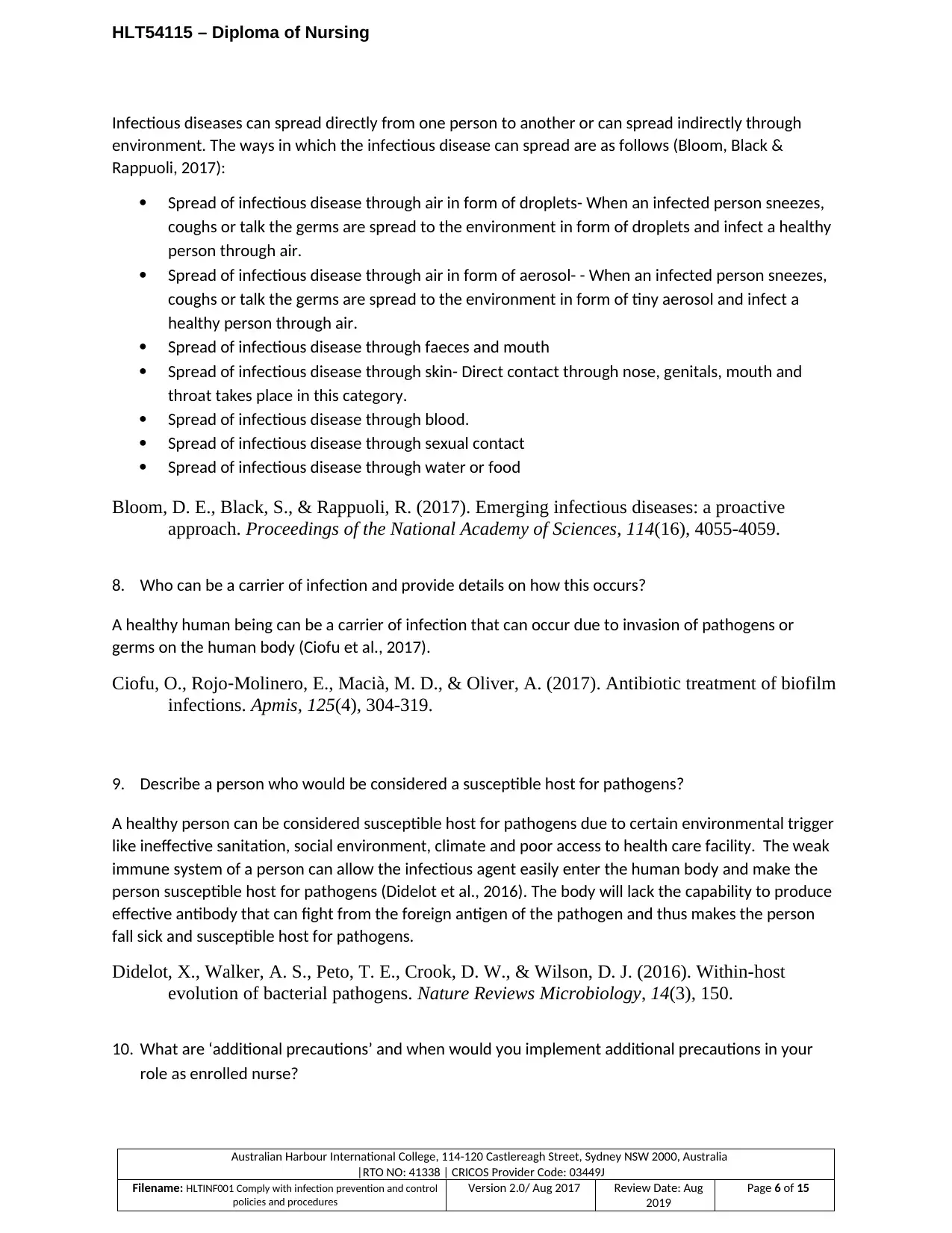
HLT54115 – Diploma of Nursing
Infectious diseases can spread directly from one person to another or can spread indirectly through
environment. The ways in which the infectious disease can spread are as follows (Bloom, Black &
Rappuoli, 2017):
Spread of infectious disease through air in form of droplets- When an infected person sneezes,
coughs or talk the germs are spread to the environment in form of droplets and infect a healthy
person through air.
Spread of infectious disease through air in form of aerosol- - When an infected person sneezes,
coughs or talk the germs are spread to the environment in form of tiny aerosol and infect a
healthy person through air.
Spread of infectious disease through faeces and mouth
Spread of infectious disease through skin- Direct contact through nose, genitals, mouth and
throat takes place in this category.
Spread of infectious disease through blood.
Spread of infectious disease through sexual contact
Spread of infectious disease through water or food
Bloom, D. E., Black, S., & Rappuoli, R. (2017). Emerging infectious diseases: a proactive
approach. Proceedings of the National Academy of Sciences, 114(16), 4055-4059.
8. Who can be a carrier of infection and provide details on how this occurs?
A healthy human being can be a carrier of infection that can occur due to invasion of pathogens or
germs on the human body (Ciofu et al., 2017).
Ciofu, O., Rojo‐Molinero, E., Macià, M. D., & Oliver, A. (2017). Antibiotic treatment of biofilm
infections. Apmis, 125(4), 304-319.
9. Describe a person who would be considered a susceptible host for pathogens?
A healthy person can be considered susceptible host for pathogens due to certain environmental trigger
like ineffective sanitation, social environment, climate and poor access to health care facility. The weak
immune system of a person can allow the infectious agent easily enter the human body and make the
person susceptible host for pathogens (Didelot et al., 2016). The body will lack the capability to produce
effective antibody that can fight from the foreign antigen of the pathogen and thus makes the person
fall sick and susceptible host for pathogens.
Didelot, X., Walker, A. S., Peto, T. E., Crook, D. W., & Wilson, D. J. (2016). Within-host
evolution of bacterial pathogens. Nature Reviews Microbiology, 14(3), 150.
10. What are ‘additional precautions’ and when would you implement additional precautions in your
role as enrolled nurse?
Australian Harbour International College, 114-120 Castlereagh Street, Sydney NSW 2000, Australia
|RTO NO: 41338 | CRICOS Provider Code: 03449J
Filename: HLTINF001 Comply with infection prevention and control
policies and procedures
Version 2.0/ Aug 2017 Review Date: Aug
2019
Page 6 of 15
Infectious diseases can spread directly from one person to another or can spread indirectly through
environment. The ways in which the infectious disease can spread are as follows (Bloom, Black &
Rappuoli, 2017):
Spread of infectious disease through air in form of droplets- When an infected person sneezes,
coughs or talk the germs are spread to the environment in form of droplets and infect a healthy
person through air.
Spread of infectious disease through air in form of aerosol- - When an infected person sneezes,
coughs or talk the germs are spread to the environment in form of tiny aerosol and infect a
healthy person through air.
Spread of infectious disease through faeces and mouth
Spread of infectious disease through skin- Direct contact through nose, genitals, mouth and
throat takes place in this category.
Spread of infectious disease through blood.
Spread of infectious disease through sexual contact
Spread of infectious disease through water or food
Bloom, D. E., Black, S., & Rappuoli, R. (2017). Emerging infectious diseases: a proactive
approach. Proceedings of the National Academy of Sciences, 114(16), 4055-4059.
8. Who can be a carrier of infection and provide details on how this occurs?
A healthy human being can be a carrier of infection that can occur due to invasion of pathogens or
germs on the human body (Ciofu et al., 2017).
Ciofu, O., Rojo‐Molinero, E., Macià, M. D., & Oliver, A. (2017). Antibiotic treatment of biofilm
infections. Apmis, 125(4), 304-319.
9. Describe a person who would be considered a susceptible host for pathogens?
A healthy person can be considered susceptible host for pathogens due to certain environmental trigger
like ineffective sanitation, social environment, climate and poor access to health care facility. The weak
immune system of a person can allow the infectious agent easily enter the human body and make the
person susceptible host for pathogens (Didelot et al., 2016). The body will lack the capability to produce
effective antibody that can fight from the foreign antigen of the pathogen and thus makes the person
fall sick and susceptible host for pathogens.
Didelot, X., Walker, A. S., Peto, T. E., Crook, D. W., & Wilson, D. J. (2016). Within-host
evolution of bacterial pathogens. Nature Reviews Microbiology, 14(3), 150.
10. What are ‘additional precautions’ and when would you implement additional precautions in your
role as enrolled nurse?
Australian Harbour International College, 114-120 Castlereagh Street, Sydney NSW 2000, Australia
|RTO NO: 41338 | CRICOS Provider Code: 03449J
Filename: HLTINF001 Comply with infection prevention and control
policies and procedures
Version 2.0/ Aug 2017 Review Date: Aug
2019
Page 6 of 15
Paraphrase This Document
Need a fresh take? Get an instant paraphrase of this document with our AI Paraphraser
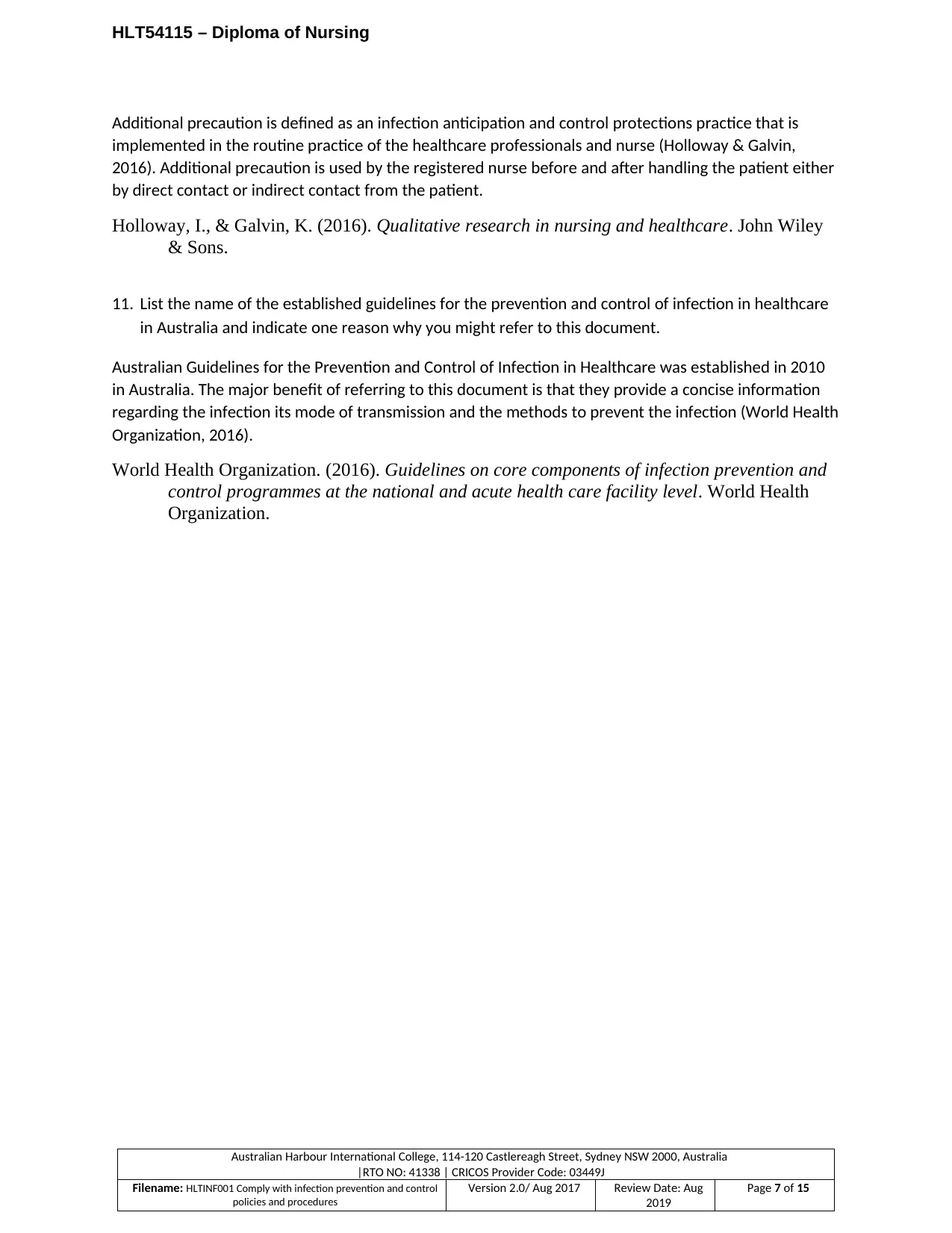
HLT54115 – Diploma of Nursing
Additional precaution is defined as an infection anticipation and control protections practice that is
implemented in the routine practice of the healthcare professionals and nurse (Holloway & Galvin,
2016). Additional precaution is used by the registered nurse before and after handling the patient either
by direct contact or indirect contact from the patient.
Holloway, I., & Galvin, K. (2016). Qualitative research in nursing and healthcare. John Wiley
& Sons.
11. List the name of the established guidelines for the prevention and control of infection in healthcare
in Australia and indicate one reason why you might refer to this document.
Australian Guidelines for the Prevention and Control of Infection in Healthcare was established in 2010
in Australia. The major benefit of referring to this document is that they provide a concise information
regarding the infection its mode of transmission and the methods to prevent the infection (World Health
Organization, 2016).
World Health Organization. (2016). Guidelines on core components of infection prevention and
control programmes at the national and acute health care facility level. World Health
Organization.
Australian Harbour International College, 114-120 Castlereagh Street, Sydney NSW 2000, Australia
|RTO NO: 41338 | CRICOS Provider Code: 03449J
Filename: HLTINF001 Comply with infection prevention and control
policies and procedures
Version 2.0/ Aug 2017 Review Date: Aug
2019
Page 7 of 15
Additional precaution is defined as an infection anticipation and control protections practice that is
implemented in the routine practice of the healthcare professionals and nurse (Holloway & Galvin,
2016). Additional precaution is used by the registered nurse before and after handling the patient either
by direct contact or indirect contact from the patient.
Holloway, I., & Galvin, K. (2016). Qualitative research in nursing and healthcare. John Wiley
& Sons.
11. List the name of the established guidelines for the prevention and control of infection in healthcare
in Australia and indicate one reason why you might refer to this document.
Australian Guidelines for the Prevention and Control of Infection in Healthcare was established in 2010
in Australia. The major benefit of referring to this document is that they provide a concise information
regarding the infection its mode of transmission and the methods to prevent the infection (World Health
Organization, 2016).
World Health Organization. (2016). Guidelines on core components of infection prevention and
control programmes at the national and acute health care facility level. World Health
Organization.
Australian Harbour International College, 114-120 Castlereagh Street, Sydney NSW 2000, Australia
|RTO NO: 41338 | CRICOS Provider Code: 03449J
Filename: HLTINF001 Comply with infection prevention and control
policies and procedures
Version 2.0/ Aug 2017 Review Date: Aug
2019
Page 7 of 15
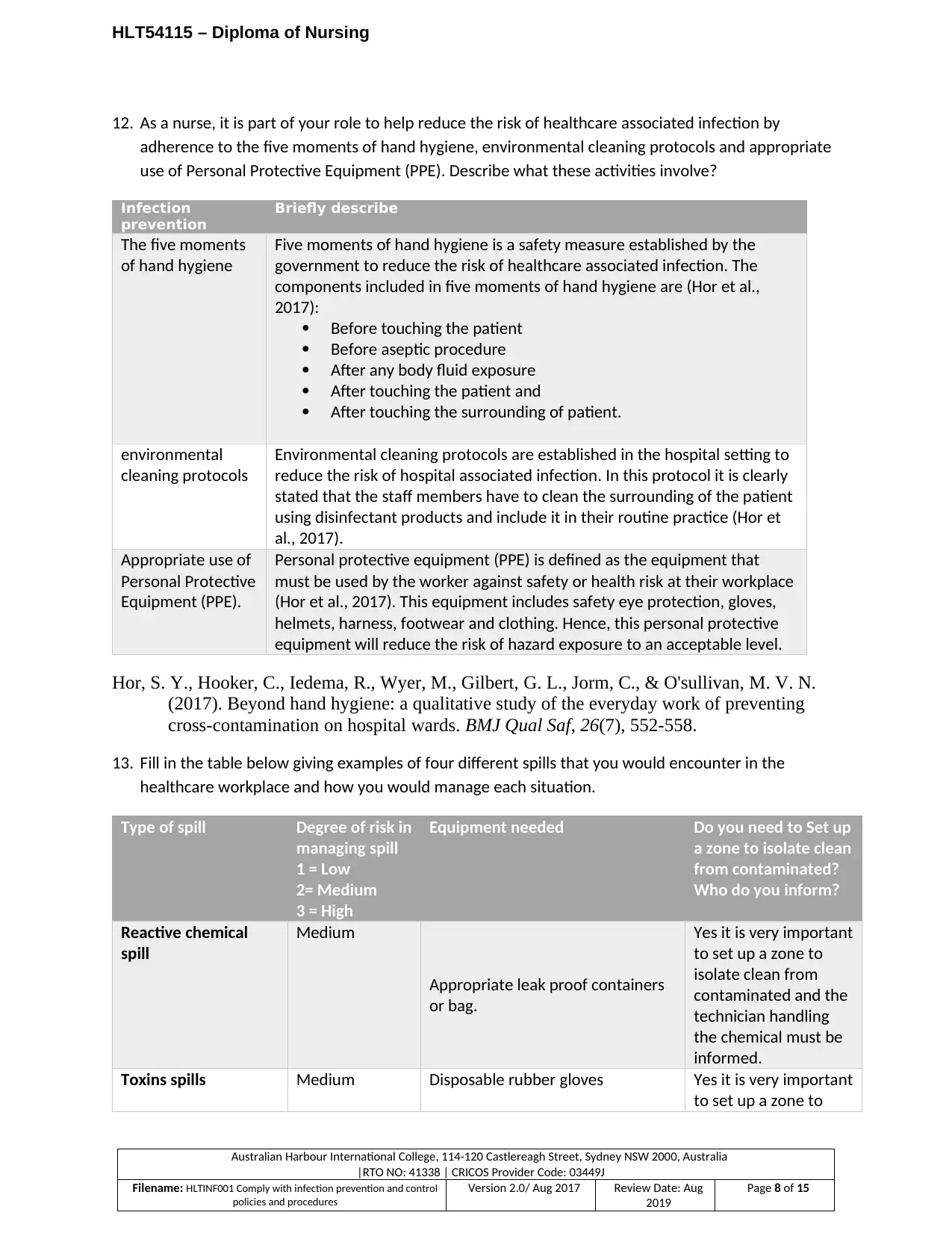
HLT54115 – Diploma of Nursing
12. As a nurse, it is part of your role to help reduce the risk of healthcare associated infection by
adherence to the five moments of hand hygiene, environmental cleaning protocols and appropriate
use of Personal Protective Equipment (PPE). Describe what these activities involve?
Infection
prevention
Briefly describe
The five moments
of hand hygiene
Five moments of hand hygiene is a safety measure established by the
government to reduce the risk of healthcare associated infection. The
components included in five moments of hand hygiene are (Hor et al.,
2017):
Before touching the patient
Before aseptic procedure
After any body fluid exposure
After touching the patient and
After touching the surrounding of patient.
environmental
cleaning protocols
Environmental cleaning protocols are established in the hospital setting to
reduce the risk of hospital associated infection. In this protocol it is clearly
stated that the staff members have to clean the surrounding of the patient
using disinfectant products and include it in their routine practice (Hor et
al., 2017).
Appropriate use of
Personal Protective
Equipment (PPE).
Personal protective equipment (PPE) is defined as the equipment that
must be used by the worker against safety or health risk at their workplace
(Hor et al., 2017). This equipment includes safety eye protection, gloves,
helmets, harness, footwear and clothing. Hence, this personal protective
equipment will reduce the risk of hazard exposure to an acceptable level.
Hor, S. Y., Hooker, C., Iedema, R., Wyer, M., Gilbert, G. L., Jorm, C., & O'sullivan, M. V. N.
(2017). Beyond hand hygiene: a qualitative study of the everyday work of preventing
cross-contamination on hospital wards. BMJ Qual Saf, 26(7), 552-558.
13. Fill in the table below giving examples of four different spills that you would encounter in the
healthcare workplace and how you would manage each situation.
Type of spill Degree of risk in
managing spill
1 = Low
2= Medium
3 = High
Equipment needed Do you need to Set up
a zone to isolate clean
from contaminated?
Who do you inform?
Reactive chemical
spill
Medium
Appropriate leak proof containers
or bag.
Yes it is very important
to set up a zone to
isolate clean from
contaminated and the
technician handling
the chemical must be
informed.
Toxins spills Medium Disposable rubber gloves Yes it is very important
to set up a zone to
Australian Harbour International College, 114-120 Castlereagh Street, Sydney NSW 2000, Australia
|RTO NO: 41338 | CRICOS Provider Code: 03449J
Filename: HLTINF001 Comply with infection prevention and control
policies and procedures
Version 2.0/ Aug 2017 Review Date: Aug
2019
Page 8 of 15
12. As a nurse, it is part of your role to help reduce the risk of healthcare associated infection by
adherence to the five moments of hand hygiene, environmental cleaning protocols and appropriate
use of Personal Protective Equipment (PPE). Describe what these activities involve?
Infection
prevention
Briefly describe
The five moments
of hand hygiene
Five moments of hand hygiene is a safety measure established by the
government to reduce the risk of healthcare associated infection. The
components included in five moments of hand hygiene are (Hor et al.,
2017):
Before touching the patient
Before aseptic procedure
After any body fluid exposure
After touching the patient and
After touching the surrounding of patient.
environmental
cleaning protocols
Environmental cleaning protocols are established in the hospital setting to
reduce the risk of hospital associated infection. In this protocol it is clearly
stated that the staff members have to clean the surrounding of the patient
using disinfectant products and include it in their routine practice (Hor et
al., 2017).
Appropriate use of
Personal Protective
Equipment (PPE).
Personal protective equipment (PPE) is defined as the equipment that
must be used by the worker against safety or health risk at their workplace
(Hor et al., 2017). This equipment includes safety eye protection, gloves,
helmets, harness, footwear and clothing. Hence, this personal protective
equipment will reduce the risk of hazard exposure to an acceptable level.
Hor, S. Y., Hooker, C., Iedema, R., Wyer, M., Gilbert, G. L., Jorm, C., & O'sullivan, M. V. N.
(2017). Beyond hand hygiene: a qualitative study of the everyday work of preventing
cross-contamination on hospital wards. BMJ Qual Saf, 26(7), 552-558.
13. Fill in the table below giving examples of four different spills that you would encounter in the
healthcare workplace and how you would manage each situation.
Type of spill Degree of risk in
managing spill
1 = Low
2= Medium
3 = High
Equipment needed Do you need to Set up
a zone to isolate clean
from contaminated?
Who do you inform?
Reactive chemical
spill
Medium
Appropriate leak proof containers
or bag.
Yes it is very important
to set up a zone to
isolate clean from
contaminated and the
technician handling
the chemical must be
informed.
Toxins spills Medium Disposable rubber gloves Yes it is very important
to set up a zone to
Australian Harbour International College, 114-120 Castlereagh Street, Sydney NSW 2000, Australia
|RTO NO: 41338 | CRICOS Provider Code: 03449J
Filename: HLTINF001 Comply with infection prevention and control
policies and procedures
Version 2.0/ Aug 2017 Review Date: Aug
2019
Page 8 of 15
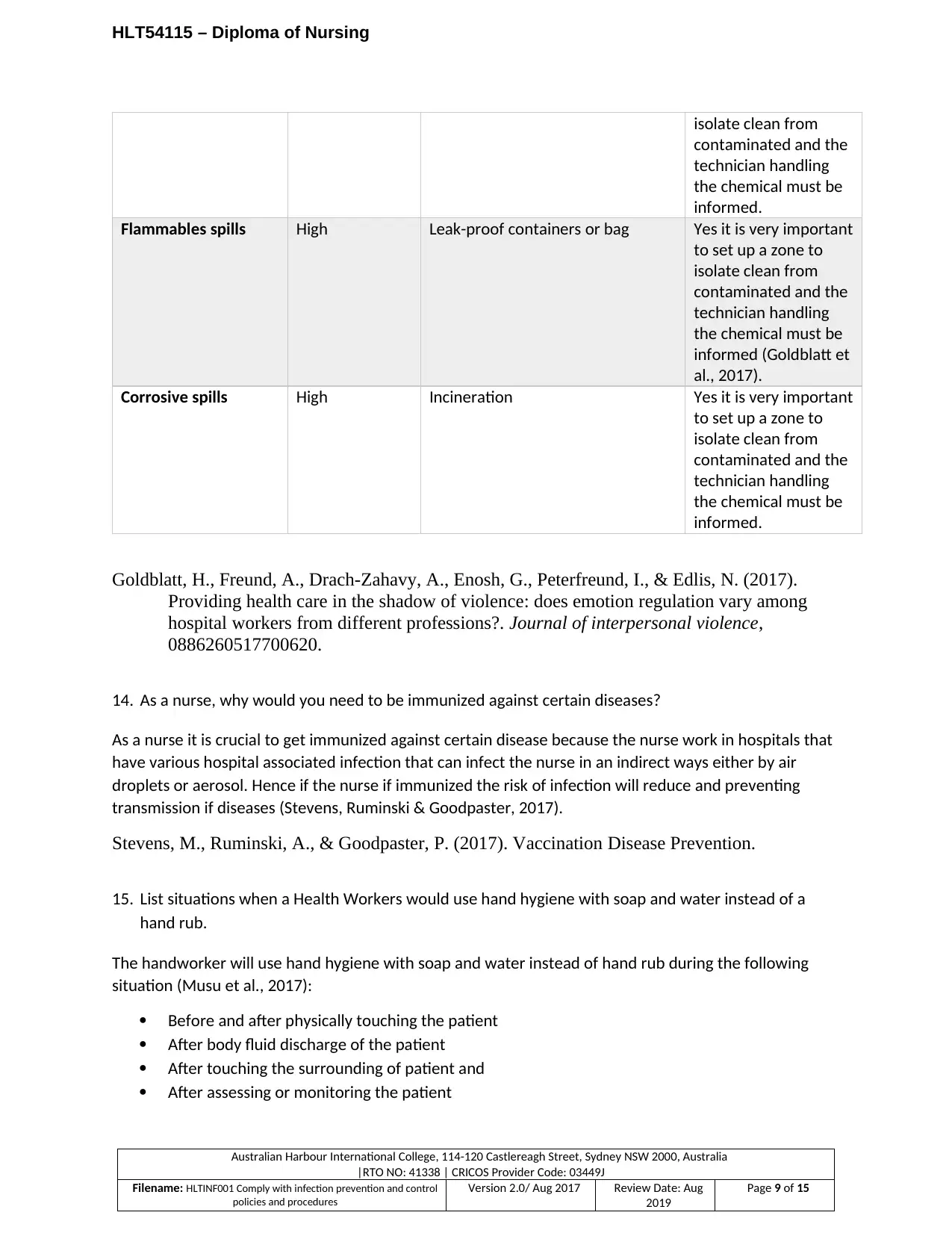
HLT54115 – Diploma of Nursing
isolate clean from
contaminated and the
technician handling
the chemical must be
informed.
Flammables spills High Leak-proof containers or bag Yes it is very important
to set up a zone to
isolate clean from
contaminated and the
technician handling
the chemical must be
informed (Goldblatt et
al., 2017).
Corrosive spills High Incineration Yes it is very important
to set up a zone to
isolate clean from
contaminated and the
technician handling
the chemical must be
informed.
Goldblatt, H., Freund, A., Drach-Zahavy, A., Enosh, G., Peterfreund, I., & Edlis, N. (2017).
Providing health care in the shadow of violence: does emotion regulation vary among
hospital workers from different professions?. Journal of interpersonal violence,
0886260517700620.
14. As a nurse, why would you need to be immunized against certain diseases?
As a nurse it is crucial to get immunized against certain disease because the nurse work in hospitals that
have various hospital associated infection that can infect the nurse in an indirect ways either by air
droplets or aerosol. Hence if the nurse if immunized the risk of infection will reduce and preventing
transmission if diseases (Stevens, Ruminski & Goodpaster, 2017).
Stevens, M., Ruminski, A., & Goodpaster, P. (2017). Vaccination Disease Prevention.
15. List situations when a Health Workers would use hand hygiene with soap and water instead of a
hand rub.
The handworker will use hand hygiene with soap and water instead of hand rub during the following
situation (Musu et al., 2017):
Before and after physically touching the patient
After body fluid discharge of the patient
After touching the surrounding of patient and
After assessing or monitoring the patient
Australian Harbour International College, 114-120 Castlereagh Street, Sydney NSW 2000, Australia
|RTO NO: 41338 | CRICOS Provider Code: 03449J
Filename: HLTINF001 Comply with infection prevention and control
policies and procedures
Version 2.0/ Aug 2017 Review Date: Aug
2019
Page 9 of 15
isolate clean from
contaminated and the
technician handling
the chemical must be
informed.
Flammables spills High Leak-proof containers or bag Yes it is very important
to set up a zone to
isolate clean from
contaminated and the
technician handling
the chemical must be
informed (Goldblatt et
al., 2017).
Corrosive spills High Incineration Yes it is very important
to set up a zone to
isolate clean from
contaminated and the
technician handling
the chemical must be
informed.
Goldblatt, H., Freund, A., Drach-Zahavy, A., Enosh, G., Peterfreund, I., & Edlis, N. (2017).
Providing health care in the shadow of violence: does emotion regulation vary among
hospital workers from different professions?. Journal of interpersonal violence,
0886260517700620.
14. As a nurse, why would you need to be immunized against certain diseases?
As a nurse it is crucial to get immunized against certain disease because the nurse work in hospitals that
have various hospital associated infection that can infect the nurse in an indirect ways either by air
droplets or aerosol. Hence if the nurse if immunized the risk of infection will reduce and preventing
transmission if diseases (Stevens, Ruminski & Goodpaster, 2017).
Stevens, M., Ruminski, A., & Goodpaster, P. (2017). Vaccination Disease Prevention.
15. List situations when a Health Workers would use hand hygiene with soap and water instead of a
hand rub.
The handworker will use hand hygiene with soap and water instead of hand rub during the following
situation (Musu et al., 2017):
Before and after physically touching the patient
After body fluid discharge of the patient
After touching the surrounding of patient and
After assessing or monitoring the patient
Australian Harbour International College, 114-120 Castlereagh Street, Sydney NSW 2000, Australia
|RTO NO: 41338 | CRICOS Provider Code: 03449J
Filename: HLTINF001 Comply with infection prevention and control
policies and procedures
Version 2.0/ Aug 2017 Review Date: Aug
2019
Page 9 of 15
Secure Best Marks with AI Grader
Need help grading? Try our AI Grader for instant feedback on your assignments.
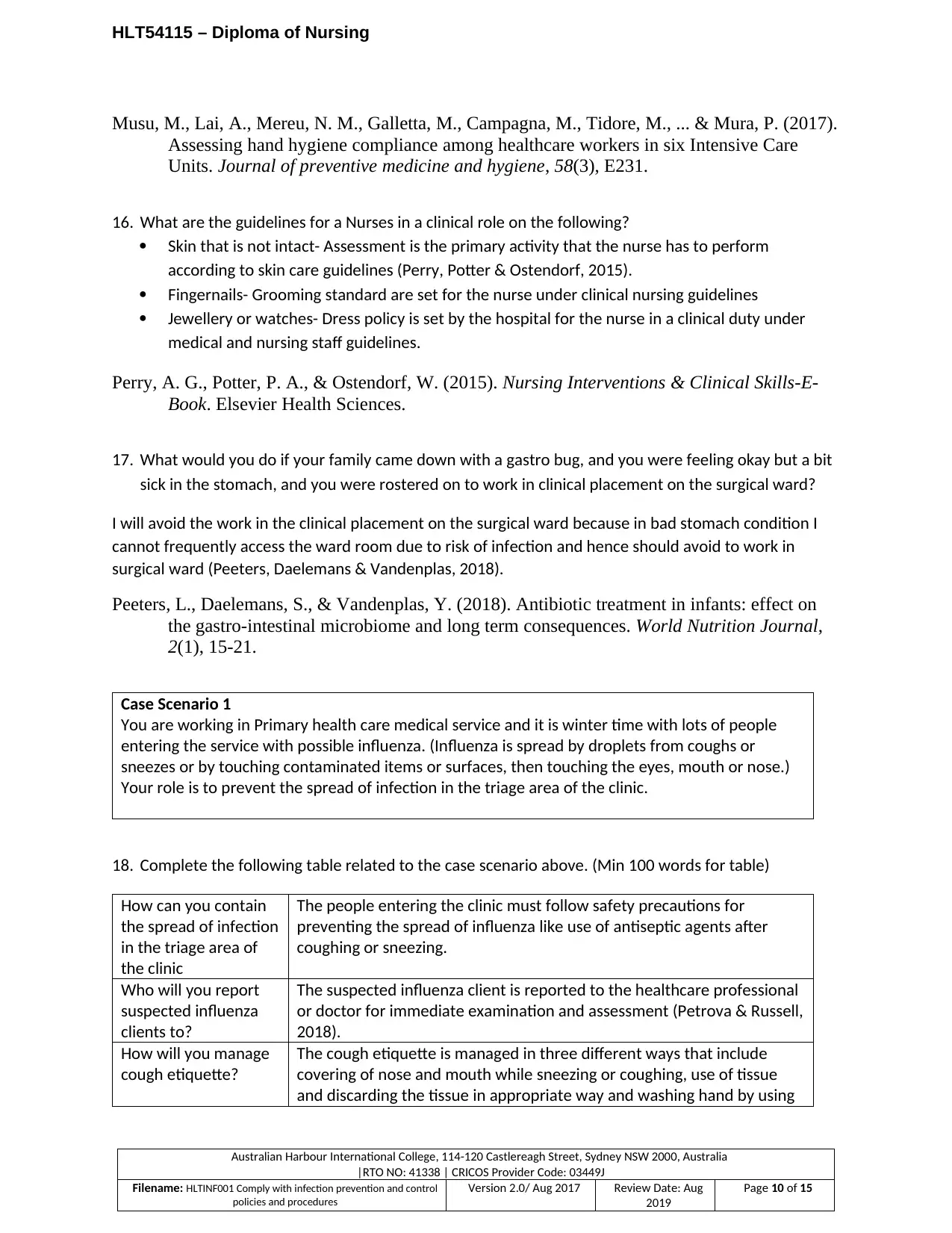
HLT54115 – Diploma of Nursing
Musu, M., Lai, A., Mereu, N. M., Galletta, M., Campagna, M., Tidore, M., ... & Mura, P. (2017).
Assessing hand hygiene compliance among healthcare workers in six Intensive Care
Units. Journal of preventive medicine and hygiene, 58(3), E231.
16. What are the guidelines for a Nurses in a clinical role on the following?
Skin that is not intact- Assessment is the primary activity that the nurse has to perform
according to skin care guidelines (Perry, Potter & Ostendorf, 2015).
Fingernails- Grooming standard are set for the nurse under clinical nursing guidelines
Jewellery or watches- Dress policy is set by the hospital for the nurse in a clinical duty under
medical and nursing staff guidelines.
Perry, A. G., Potter, P. A., & Ostendorf, W. (2015). Nursing Interventions & Clinical Skills-E-
Book. Elsevier Health Sciences.
17. What would you do if your family came down with a gastro bug, and you were feeling okay but a bit
sick in the stomach, and you were rostered on to work in clinical placement on the surgical ward?
I will avoid the work in the clinical placement on the surgical ward because in bad stomach condition I
cannot frequently access the ward room due to risk of infection and hence should avoid to work in
surgical ward (Peeters, Daelemans & Vandenplas, 2018).
Peeters, L., Daelemans, S., & Vandenplas, Y. (2018). Antibiotic treatment in infants: effect on
the gastro-intestinal microbiome and long term consequences. World Nutrition Journal,
2(1), 15-21.
Case Scenario 1
You are working in Primary health care medical service and it is winter time with lots of people
entering the service with possible influenza. (Influenza is spread by droplets from coughs or
sneezes or by touching contaminated items or surfaces, then touching the eyes, mouth or nose.)
Your role is to prevent the spread of infection in the triage area of the clinic.
18. Complete the following table related to the case scenario above. (Min 100 words for table)
How can you contain
the spread of infection
in the triage area of
the clinic
The people entering the clinic must follow safety precautions for
preventing the spread of influenza like use of antiseptic agents after
coughing or sneezing.
Who will you report
suspected influenza
clients to?
The suspected influenza client is reported to the healthcare professional
or doctor for immediate examination and assessment (Petrova & Russell,
2018).
How will you manage
cough etiquette?
The cough etiquette is managed in three different ways that include
covering of nose and mouth while sneezing or coughing, use of tissue
and discarding the tissue in appropriate way and washing hand by using
Australian Harbour International College, 114-120 Castlereagh Street, Sydney NSW 2000, Australia
|RTO NO: 41338 | CRICOS Provider Code: 03449J
Filename: HLTINF001 Comply with infection prevention and control
policies and procedures
Version 2.0/ Aug 2017 Review Date: Aug
2019
Page 10 of 15
Musu, M., Lai, A., Mereu, N. M., Galletta, M., Campagna, M., Tidore, M., ... & Mura, P. (2017).
Assessing hand hygiene compliance among healthcare workers in six Intensive Care
Units. Journal of preventive medicine and hygiene, 58(3), E231.
16. What are the guidelines for a Nurses in a clinical role on the following?
Skin that is not intact- Assessment is the primary activity that the nurse has to perform
according to skin care guidelines (Perry, Potter & Ostendorf, 2015).
Fingernails- Grooming standard are set for the nurse under clinical nursing guidelines
Jewellery or watches- Dress policy is set by the hospital for the nurse in a clinical duty under
medical and nursing staff guidelines.
Perry, A. G., Potter, P. A., & Ostendorf, W. (2015). Nursing Interventions & Clinical Skills-E-
Book. Elsevier Health Sciences.
17. What would you do if your family came down with a gastro bug, and you were feeling okay but a bit
sick in the stomach, and you were rostered on to work in clinical placement on the surgical ward?
I will avoid the work in the clinical placement on the surgical ward because in bad stomach condition I
cannot frequently access the ward room due to risk of infection and hence should avoid to work in
surgical ward (Peeters, Daelemans & Vandenplas, 2018).
Peeters, L., Daelemans, S., & Vandenplas, Y. (2018). Antibiotic treatment in infants: effect on
the gastro-intestinal microbiome and long term consequences. World Nutrition Journal,
2(1), 15-21.
Case Scenario 1
You are working in Primary health care medical service and it is winter time with lots of people
entering the service with possible influenza. (Influenza is spread by droplets from coughs or
sneezes or by touching contaminated items or surfaces, then touching the eyes, mouth or nose.)
Your role is to prevent the spread of infection in the triage area of the clinic.
18. Complete the following table related to the case scenario above. (Min 100 words for table)
How can you contain
the spread of infection
in the triage area of
the clinic
The people entering the clinic must follow safety precautions for
preventing the spread of influenza like use of antiseptic agents after
coughing or sneezing.
Who will you report
suspected influenza
clients to?
The suspected influenza client is reported to the healthcare professional
or doctor for immediate examination and assessment (Petrova & Russell,
2018).
How will you manage
cough etiquette?
The cough etiquette is managed in three different ways that include
covering of nose and mouth while sneezing or coughing, use of tissue
and discarding the tissue in appropriate way and washing hand by using
Australian Harbour International College, 114-120 Castlereagh Street, Sydney NSW 2000, Australia
|RTO NO: 41338 | CRICOS Provider Code: 03449J
Filename: HLTINF001 Comply with infection prevention and control
policies and procedures
Version 2.0/ Aug 2017 Review Date: Aug
2019
Page 10 of 15
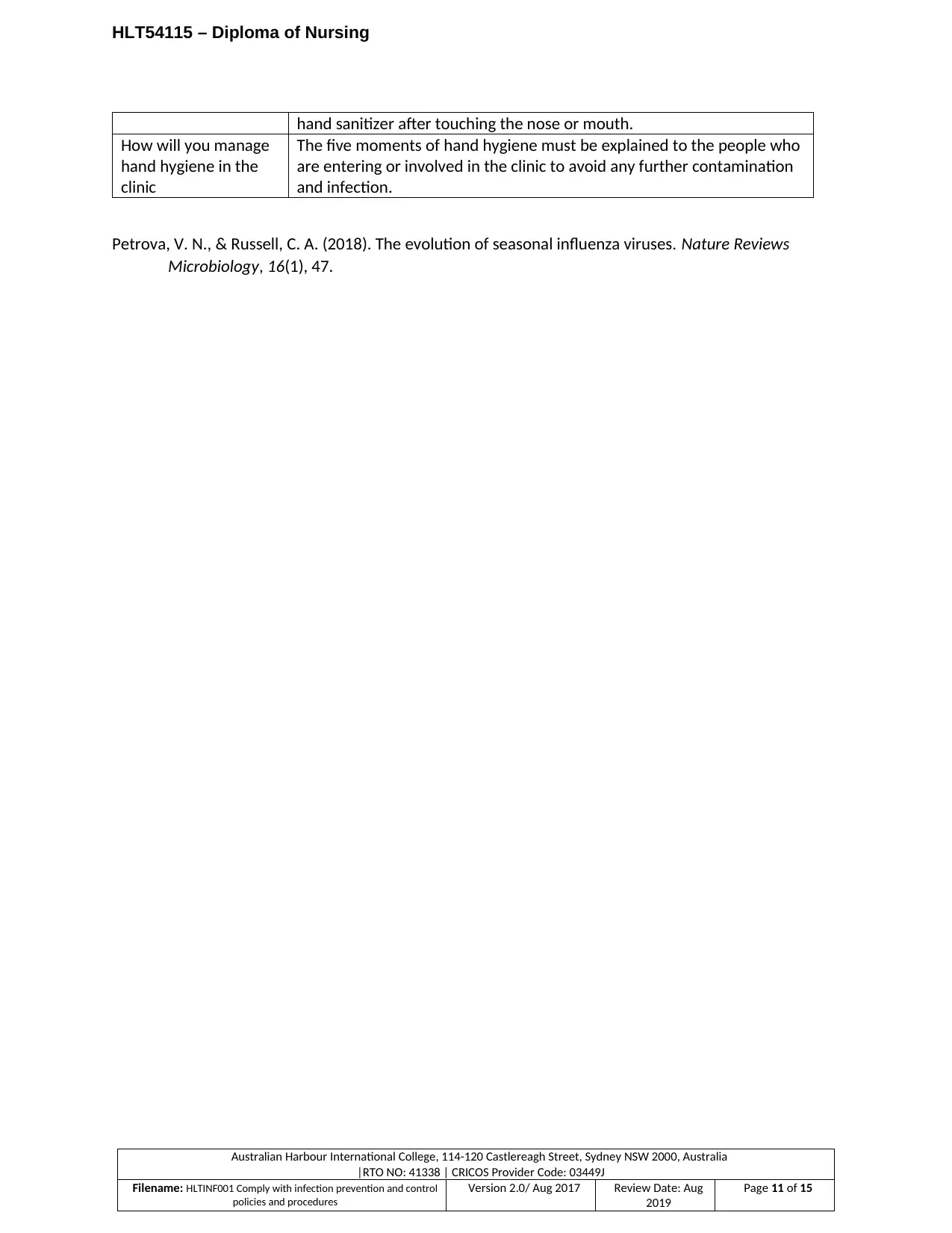
HLT54115 – Diploma of Nursing
hand sanitizer after touching the nose or mouth.
How will you manage
hand hygiene in the
clinic
The five moments of hand hygiene must be explained to the people who
are entering or involved in the clinic to avoid any further contamination
and infection.
Petrova, V. N., & Russell, C. A. (2018). The evolution of seasonal influenza viruses. Nature Reviews
Microbiology, 16(1), 47.
Australian Harbour International College, 114-120 Castlereagh Street, Sydney NSW 2000, Australia
|RTO NO: 41338 | CRICOS Provider Code: 03449J
Filename: HLTINF001 Comply with infection prevention and control
policies and procedures
Version 2.0/ Aug 2017 Review Date: Aug
2019
Page 11 of 15
hand sanitizer after touching the nose or mouth.
How will you manage
hand hygiene in the
clinic
The five moments of hand hygiene must be explained to the people who
are entering or involved in the clinic to avoid any further contamination
and infection.
Petrova, V. N., & Russell, C. A. (2018). The evolution of seasonal influenza viruses. Nature Reviews
Microbiology, 16(1), 47.
Australian Harbour International College, 114-120 Castlereagh Street, Sydney NSW 2000, Australia
|RTO NO: 41338 | CRICOS Provider Code: 03449J
Filename: HLTINF001 Comply with infection prevention and control
policies and procedures
Version 2.0/ Aug 2017 Review Date: Aug
2019
Page 11 of 15
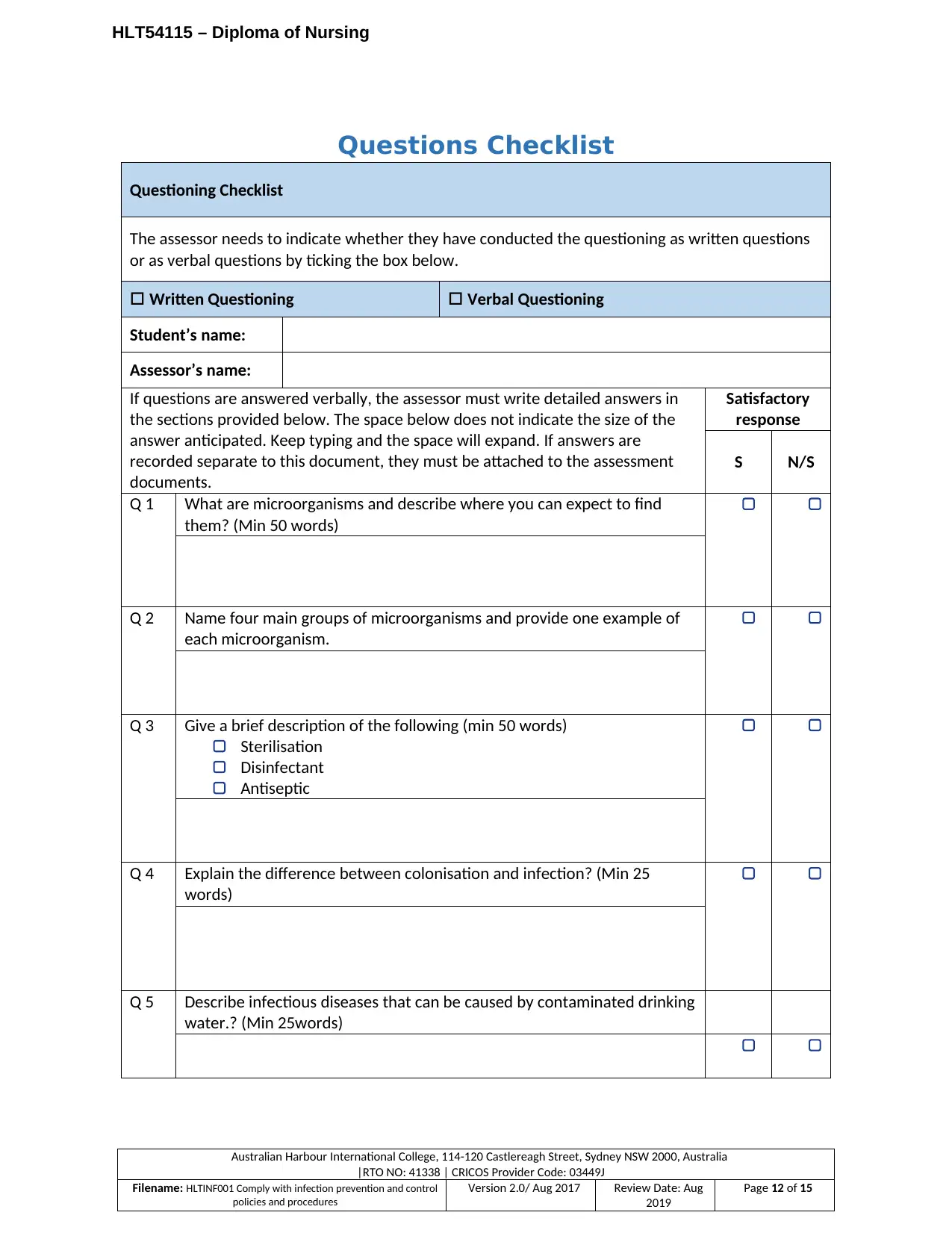
HLT54115 – Diploma of Nursing
Questions Checklist
Questioning Checklist
The assessor needs to indicate whether they have conducted the questioning as written questions
or as verbal questions by ticking the box below.
Written Questioning Verbal Questioning
Student’s name:
Assessor’s name:
If questions are answered verbally, the assessor must write detailed answers in
the sections provided below. The space below does not indicate the size of the
answer anticipated. Keep typing and the space will expand. If answers are
recorded separate to this document, they must be attached to the assessment
documents.
Satisfactory
response
S N/S
Q 1 What are microorganisms and describe where you can expect to find
them? (Min 50 words)
Q 2 Name four main groups of microorganisms and provide one example of
each microorganism.
Q 3 Give a brief description of the following (min 50 words)
Sterilisation
Disinfectant
Antiseptic
Q 4 Explain the difference between colonisation and infection? (Min 25
words)
Q 5 Describe infectious diseases that can be caused by contaminated drinking
water.? (Min 25words)
Australian Harbour International College, 114-120 Castlereagh Street, Sydney NSW 2000, Australia
|RTO NO: 41338 | CRICOS Provider Code: 03449J
Filename: HLTINF001 Comply with infection prevention and control
policies and procedures
Version 2.0/ Aug 2017 Review Date: Aug
2019
Page 12 of 15
Questions Checklist
Questioning Checklist
The assessor needs to indicate whether they have conducted the questioning as written questions
or as verbal questions by ticking the box below.
Written Questioning Verbal Questioning
Student’s name:
Assessor’s name:
If questions are answered verbally, the assessor must write detailed answers in
the sections provided below. The space below does not indicate the size of the
answer anticipated. Keep typing and the space will expand. If answers are
recorded separate to this document, they must be attached to the assessment
documents.
Satisfactory
response
S N/S
Q 1 What are microorganisms and describe where you can expect to find
them? (Min 50 words)
Q 2 Name four main groups of microorganisms and provide one example of
each microorganism.
Q 3 Give a brief description of the following (min 50 words)
Sterilisation
Disinfectant
Antiseptic
Q 4 Explain the difference between colonisation and infection? (Min 25
words)
Q 5 Describe infectious diseases that can be caused by contaminated drinking
water.? (Min 25words)
Australian Harbour International College, 114-120 Castlereagh Street, Sydney NSW 2000, Australia
|RTO NO: 41338 | CRICOS Provider Code: 03449J
Filename: HLTINF001 Comply with infection prevention and control
policies and procedures
Version 2.0/ Aug 2017 Review Date: Aug
2019
Page 12 of 15
Paraphrase This Document
Need a fresh take? Get an instant paraphrase of this document with our AI Paraphraser
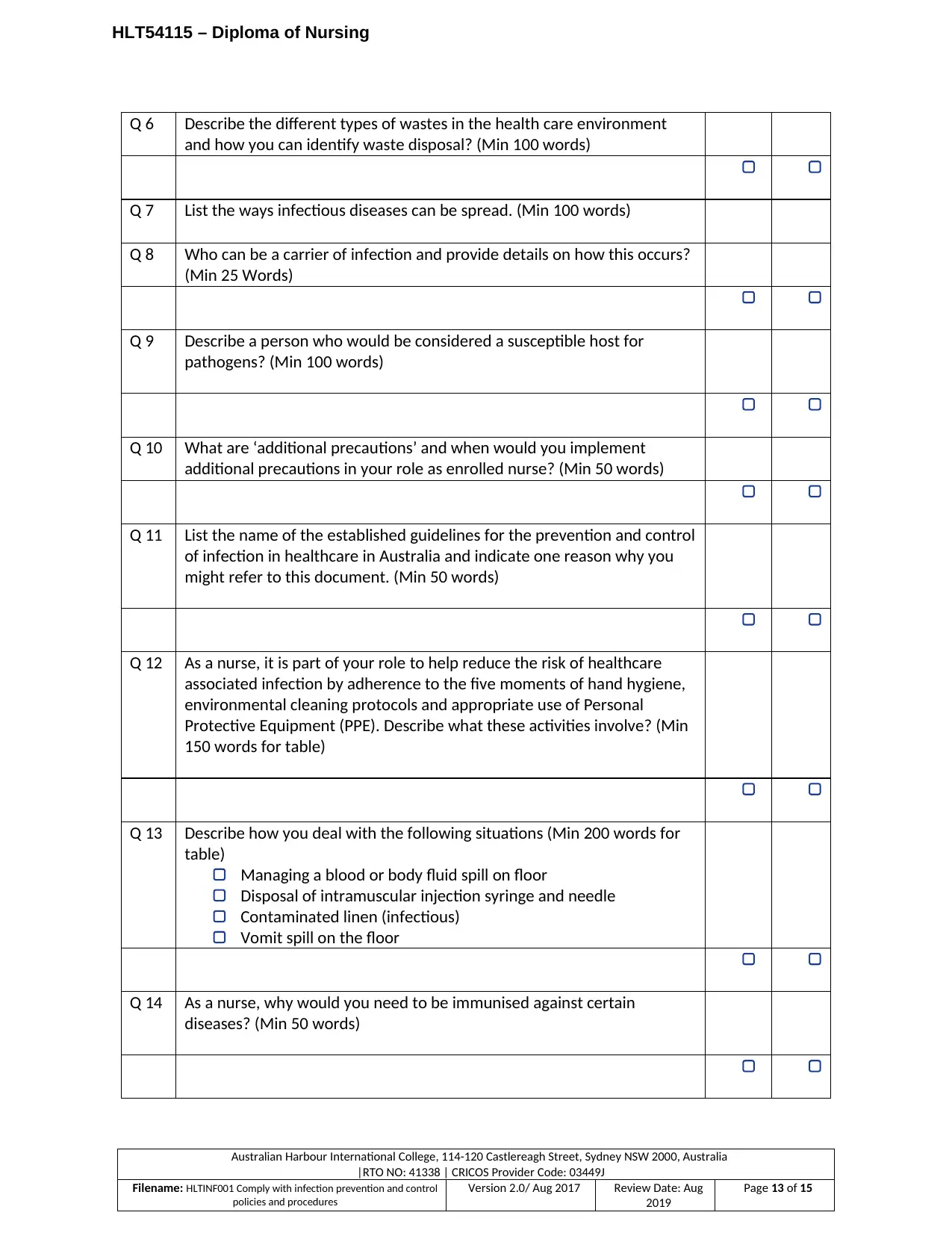
HLT54115 – Diploma of Nursing
Q 6 Describe the different types of wastes in the health care environment
and how you can identify waste disposal? (Min 100 words)
Q 7 List the ways infectious diseases can be spread. (Min 100 words)
Q 8 Who can be a carrier of infection and provide details on how this occurs?
(Min 25 Words)
Q 9 Describe a person who would be considered a susceptible host for
pathogens? (Min 100 words)
Q 10 What are ‘additional precautions’ and when would you implement
additional precautions in your role as enrolled nurse? (Min 50 words)
Q 11 List the name of the established guidelines for the prevention and control
of infection in healthcare in Australia and indicate one reason why you
might refer to this document. (Min 50 words)
Q 12 As a nurse, it is part of your role to help reduce the risk of healthcare
associated infection by adherence to the five moments of hand hygiene,
environmental cleaning protocols and appropriate use of Personal
Protective Equipment (PPE). Describe what these activities involve? (Min
150 words for table)
Q 13 Describe how you deal with the following situations (Min 200 words for
table)
Managing a blood or body fluid spill on floor
Disposal of intramuscular injection syringe and needle
Contaminated linen (infectious)
Vomit spill on the floor
Q 14 As a nurse, why would you need to be immunised against certain
diseases? (Min 50 words)
Australian Harbour International College, 114-120 Castlereagh Street, Sydney NSW 2000, Australia
|RTO NO: 41338 | CRICOS Provider Code: 03449J
Filename: HLTINF001 Comply with infection prevention and control
policies and procedures
Version 2.0/ Aug 2017 Review Date: Aug
2019
Page 13 of 15
Q 6 Describe the different types of wastes in the health care environment
and how you can identify waste disposal? (Min 100 words)
Q 7 List the ways infectious diseases can be spread. (Min 100 words)
Q 8 Who can be a carrier of infection and provide details on how this occurs?
(Min 25 Words)
Q 9 Describe a person who would be considered a susceptible host for
pathogens? (Min 100 words)
Q 10 What are ‘additional precautions’ and when would you implement
additional precautions in your role as enrolled nurse? (Min 50 words)
Q 11 List the name of the established guidelines for the prevention and control
of infection in healthcare in Australia and indicate one reason why you
might refer to this document. (Min 50 words)
Q 12 As a nurse, it is part of your role to help reduce the risk of healthcare
associated infection by adherence to the five moments of hand hygiene,
environmental cleaning protocols and appropriate use of Personal
Protective Equipment (PPE). Describe what these activities involve? (Min
150 words for table)
Q 13 Describe how you deal with the following situations (Min 200 words for
table)
Managing a blood or body fluid spill on floor
Disposal of intramuscular injection syringe and needle
Contaminated linen (infectious)
Vomit spill on the floor
Q 14 As a nurse, why would you need to be immunised against certain
diseases? (Min 50 words)
Australian Harbour International College, 114-120 Castlereagh Street, Sydney NSW 2000, Australia
|RTO NO: 41338 | CRICOS Provider Code: 03449J
Filename: HLTINF001 Comply with infection prevention and control
policies and procedures
Version 2.0/ Aug 2017 Review Date: Aug
2019
Page 13 of 15
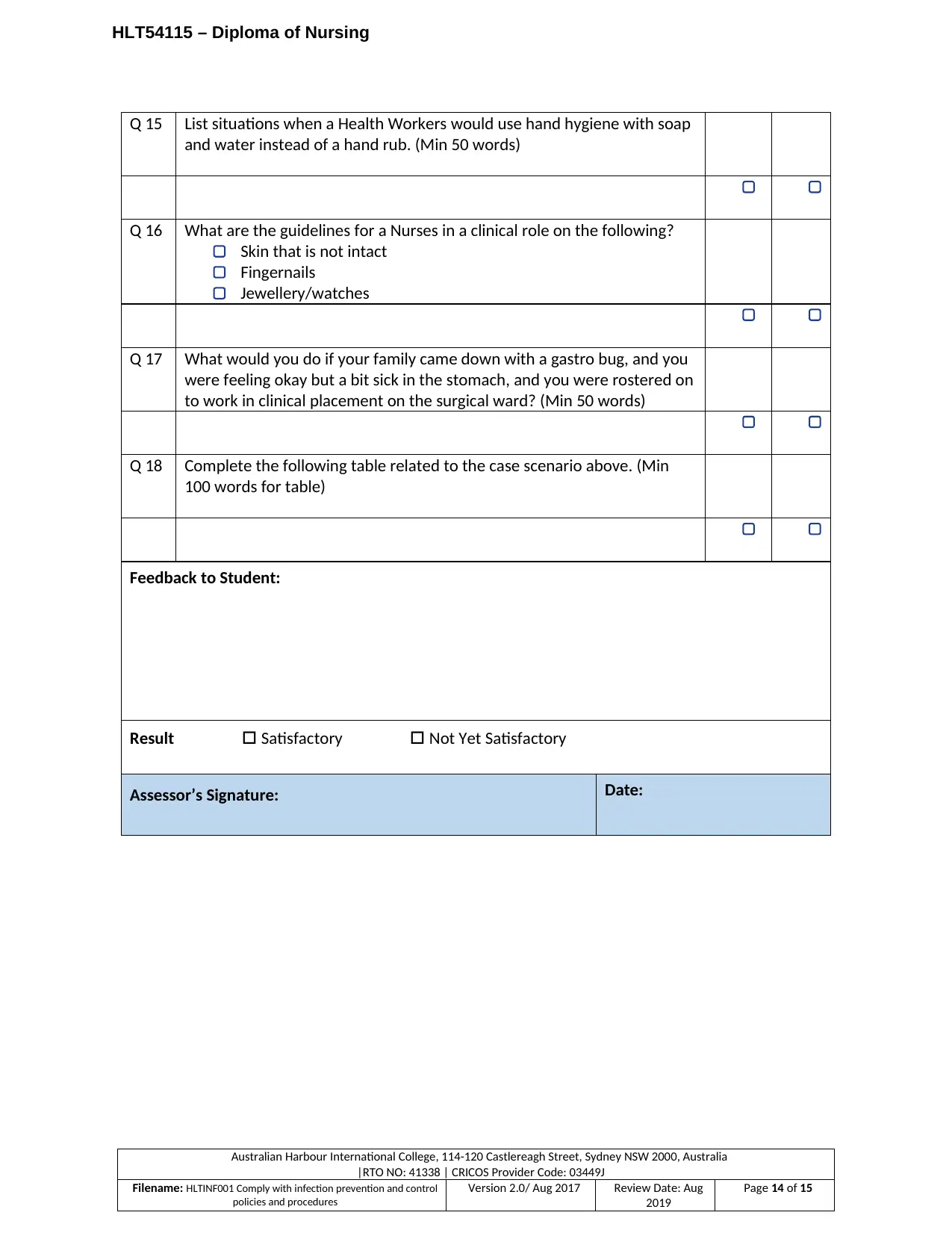
HLT54115 – Diploma of Nursing
Q 15 List situations when a Health Workers would use hand hygiene with soap
and water instead of a hand rub. (Min 50 words)
Q 16 What are the guidelines for a Nurses in a clinical role on the following?
Skin that is not intact
Fingernails
Jewellery/watches
Q 17 What would you do if your family came down with a gastro bug, and you
were feeling okay but a bit sick in the stomach, and you were rostered on
to work in clinical placement on the surgical ward? (Min 50 words)
Q 18 Complete the following table related to the case scenario above. (Min
100 words for table)
Feedback to Student:
Result Satisfactory Not Yet Satisfactory
Assessor’s Signature: Date:
Australian Harbour International College, 114-120 Castlereagh Street, Sydney NSW 2000, Australia
|RTO NO: 41338 | CRICOS Provider Code: 03449J
Filename: HLTINF001 Comply with infection prevention and control
policies and procedures
Version 2.0/ Aug 2017 Review Date: Aug
2019
Page 14 of 15
Q 15 List situations when a Health Workers would use hand hygiene with soap
and water instead of a hand rub. (Min 50 words)
Q 16 What are the guidelines for a Nurses in a clinical role on the following?
Skin that is not intact
Fingernails
Jewellery/watches
Q 17 What would you do if your family came down with a gastro bug, and you
were feeling okay but a bit sick in the stomach, and you were rostered on
to work in clinical placement on the surgical ward? (Min 50 words)
Q 18 Complete the following table related to the case scenario above. (Min
100 words for table)
Feedback to Student:
Result Satisfactory Not Yet Satisfactory
Assessor’s Signature: Date:
Australian Harbour International College, 114-120 Castlereagh Street, Sydney NSW 2000, Australia
|RTO NO: 41338 | CRICOS Provider Code: 03449J
Filename: HLTINF001 Comply with infection prevention and control
policies and procedures
Version 2.0/ Aug 2017 Review Date: Aug
2019
Page 14 of 15
1 out of 15
Related Documents
Your All-in-One AI-Powered Toolkit for Academic Success.
+13062052269
info@desklib.com
Available 24*7 on WhatsApp / Email
![[object Object]](/_next/static/media/star-bottom.7253800d.svg)
Unlock your academic potential
© 2024 | Zucol Services PVT LTD | All rights reserved.





